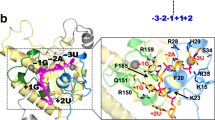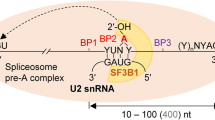Abstract
Point mutations can generate defective and sometimes harmful proteins. The nonsense-mediated mRNA decay (NMD) pathway minimizes the potential damage caused by nonsense mutations1,2,3,4. In-frame nonsense codons located at a minimum distance upstream of the last exon-exon junction are recognized as premature termination codons (PTCs), targeting the mRNA for degradation. Some nonsense mutations cause skipping of one or more exons, presumably during pre-mRNA splicing in the nucleus; this phenomenon is termed nonsense-mediated altered splicing (NAS), and its underlying mechanism is unclear1,2,5,6. By analyzing NAS in BRCA1, we show here that inappropriate exon skipping can be reproduced in vitro, and results from disruption of a splicing enhancer in the coding sequence. Enhancers can be disrupted by single nonsense, missense and translationally silent point mutations, without recognition of an open reading frame as such. These results argue against a nuclear reading-frame scanning mechanism for NAS. Coding-region single-nucleotide polymorphisms7 (cSNPs) within exonic splicing enhancers or silencers may affect the patterns or efficiency of mRNA splicing, which may in turn cause phenotypic variability and variable penetrance of mutations elsewhere in a gene.
This is a preview of subscription content, access via your institution
Access options
Subscribe to this journal
Receive 12 print issues and online access
$209.00 per year
only $17.42 per issue
Buy this article
- Purchase on Springer Link
- Instant access to full article PDF
Prices may be subject to local taxes which are calculated during checkout



Similar content being viewed by others
References
Maquat, L.E. Defects in RNA splicing and the consequence of shortened translational reading frames. Am. J. Hum. Genet. 59, 279– 286 (1996).
Hentze, M.W. & Kulozik, A.E. A perfect message: RNA surveillance and nonsense-mediated decay. Cell 96, 307 –310 (1999).
Jacobson, A. & Peltz, S.W. Interrelationships of the pathways of mRNA decay and translation in eukaryotic cells. Annu. Rev. Biochem. 65, 693–739 ( 1996).
Li, S. & Wilkinson, M.F. Nonsense surveillance in lymphocytes? Immunity 8, 135–141 (1998).
Dietz, H.C. Nonsense mutations and altered splice-site selection. Am. J. Hum. Genet. 60, 729–730 ( 1997).
Valentine, C.R. The association of nonsense codons with exon skipping. Mutat. Res. 411, 87–117 ( 1998).
Cargill, M. et al. Characterization of single-nucleotide polymorphisms in coding regions of human genes. Nature Genet. 22, 231–238 (1999).
Cooper, T.A. & Mattox, W. The regulation of splice-site selection, and its role in human disease. Am. J. Hum. Genet. 61 , 259–266 (1997).
Gersappe, A. & Pintel, D.J. A premature termination codon interferes with the nuclear function of an exon splicing enhancer in an open reading frame-dependent manner. Mol. Cell. Biol. 19, 1640–1650 (1999).
Shiga, N. et al. Disruption of the splicing enhancer sequence within exon 27 of the dystrophin gene by a nonsense mutation induces partial skipping of the exon and is responsible for Becker muscular dystrophy. J. Clin. Invest. 100, 2204–2210 ( 1997).
Shen, L.X., Basilion, J.P. & Stanton, V.P. Single-nucleotide polymorphisms can cause different structural folds of mRNA. Proc. Natl. Acad. Sci. USA 96, 7871–7876 (1999).
D'Souza, I. et al. Missense and silent tau gene mutations cause frontotemporal dementia with parkinsonism-chromosome 17 type, by affecting multiple alternative RNA splicing regulatory elements. Proc. Natl. Acad. Sci. USA 96, 5598–5603 (1999).
Vuillaumier-Barrot, S. et al. Characterization of the 415G>A (E139K) PMM2 mutation in carbohydrate-deficient glycoprotein syndrome type Ia disrupting a splicing enhancer resulting in exon 5 skipping. Hum. Mut. 14, 543– 544 (1999).
Watakabe, A., Tanaka, K. & Shimura, Y. The role of exon sequences in splice site selection . Genes Dev. 7, 407–418 (1993).
Cáceres, J.F. & Krainer, A.R. Mammalian pre-mRNA splicing factors. in Eukaryotic mRNA Processing (ed. Krainer, A.R.) 174–212 (IRL Press, Oxford, 1997).
Valcárcel, J. & Green, M.R. The SR protein family: pleiotropic functions in pre-mRNA splicing. Trends Biochem. Sci. 21, 296–301 ( 1996).
Liu, H.-X., Zhang, M. & Krainer, A.R. Identification of functional exonic splicing enhancer motifs recognized by individual SR proteins. Genes Dev. 12, 1998–2012 (1998).
Schaal, T.D. & Maniatis, T. Selection and characterization of pre-mRNA splicing enhancers: identification of novel SR protein-specific enhancer sequences. Mol. Cell. Biol. 19, 1705–1719 (1999).
Liu, H.-X., Chew, S.L., Cartegni, L., Zhang, M.Q. & Krainer, A.R. Exonic splicing enhancer motif recognized by human SC35 under splicing conditions. Mol. Cell. Biol. 20 , 1063–1071 (2000).
Mazoyer, S. et al. A BRCA1 nonsense mutation causes exon skipping. Am. J. Hum. Genet. 62, 713–715 (1998).
Tian, H. & Kole, R. Selection of novel exon recognition elements from a pool of random sequences. Mol. Cell. Biol. 15, 6291–6298 (1995).
Coulter, L.R., Landree, M.A. & Cooper, T.A. Identification of a new class of exonic splicing enhancers by in vivo selection. Mol. Cell. Biol. 17, 2143–2150 (1997).
Mayeda, A. & Krainer, A.R. Preparation of Hela cell nuclear and cytosolic S100 extracts for in vitro splicing. Methods Mol. Biol. 118, 309–314 ( 1999).
Mayeda, A. & Krainer, A.R. Mammalian in vitro splicing assays . Methods Mol. Biol. 118, 315– 321 (1999).
Muro, A. et al. Regulation of fibronectin EDA exon alternative splicing: possible role of RNA secondary structure for enhancer display. Mol. Cell. Biol. 19, 2657–2671 ( 1999).
Krawczak, M., Reiss, J. & Cooper, D.N. The mutational spectrum of single base-pair substitutions in mRNA splice junctions of human genes: causes and consequences. Hum. Genet. 90, 41–54 ( 1992).
Ars, E. et al. Mutations affecting mRNA splicing are the most common molecular defects in patients with neurofibromatosis type 1. Hum. Mol. Genet. 9, 237–247 ( 2000).
Teraoka, S.N. et al. Splicing defects in the ataxia-telangectasia gene, ATM : underlying mutations and consequences. Am. J. Hum. Genet. 64, 1617–1631 ( 1999).
Schaal, T.D. & Maniatis, T. Multiple distinct splicing enhancers in the protein-coding sequences of a constitutively spliced mRNA. Mol. Cell. Biol. 19, 261–273 (1999).
Mayeda, A., Screaton, G., Chandler, S.D., Fu, X.-D. & Krainer, A.R. Substrate specificities of SR proteins in constitutive splicing are determined by their RRMs and composite pre-mRNA exonic elements. Mol. Cell. Biol. 19, 1853–1863 (1999).
Acknowledgements
We thank M. Hastings for comments on the manuscript, and members of the Krainer laboratory for many helpful discussions. This work was supported by NIH grants GM42699 and CA13106 (A.R.K.), by NIH grant HG01696 (M.Q.Z.), and by postdoctoral fellowships from the U.S. Army Medical Research and Matériel command (H.-X.L.) and the Human Frontiers Science Program (L.C.).
Author information
Authors and Affiliations
Corresponding author
Rights and permissions
About this article
Cite this article
Liu, HX., Cartegni, L., Zhang, M. et al. A mechanism for exon skipping caused by nonsense or missense mutations in BRCA1 and other genes. Nat Genet 27, 55–58 (2001). https://doi.org/10.1038/83762
Received:
Accepted:
Issue Date:
DOI: https://doi.org/10.1038/83762
This article is cited by
-
A novel SPTB mutation causes hereditary spherocytosis via loss-of-function of β-spectrin
Annals of Hematology (2022)
-
Identification of exon skipping events associated with Alzheimer’s disease in the human hippocampus
BMC Medical Genomics (2019)
-
A synonymous germline variant PALB2 c.18G>T (p.Gly6=) disrupts normal splicing in a family with pancreatic and breast cancers
Breast Cancer Research and Treatment (2019)
-
SLC4A4 compound heterozygous mutations in exon–intron boundary regions presenting with severe proximal renal tubular acidosis and extrarenal symptoms coexisting with Turner’s syndrome: a case report
BMC Medical Genetics (2018)
-
CRISPR/Cas9-mediated genome editing induces exon skipping by complete or stochastic altering splicing in the migratory locust
BMC Biotechnology (2018)



